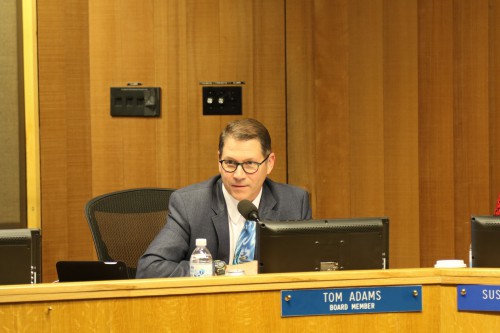

In the aftermath of the implementation of AIM reforms enacted in November, with a recent update showing a loss of diversity in the program as well as concerns about the ongoing achievement gap and efforts to deal with it through LCAP (Local Control and Accountability Plan) and Common Core, the Vanguard has reached out to the school board members to get their thoughts on these key issues.
Previously we had Susan Lovenburg and Alan Fernandes and Barbara Archer. Here are Tom Adam’s responses.
What are your thoughts on the progress of the AIM reform? Do you have concerns about the underrepresentation of blacks and Hispanics among those currently identified? Do you have concerns about identifying only 46 students this year at the hypothetical 98th percentile?
The AIM identification process ensures consistency and transparency. While the district has new assessments, there is an understanding that we will need to look at other available tests for improving the identification process. As for African American and Latino/Latina students, this is an ongoing concern and we will need to have the most appropriate assessment for identifying all of our AIM students. The AIM Assessment Team ensures a variety of educators are involved in the identification of students.
What do you see as the key to alleviating the achievement gap?
Closing the achievement gap is not done easily or overnight, but there are some actions that can be done now. First, Davis must make sure that all of its students feel welcomed and that the district cares about meeting their needs. The annual survey of school climate will tell us whether students feel connected to their school and that they have a safe learning environment. Expanding funding for elementary counselors is another step in ensuring our students’ social-emotional needs are met. As for long-term solutions, preschool provides the opportunity to connect early with students, and Davis should expand its existing preschool efforts. Preschool will ensure social and emotional development, while broadening pre-literacy skills, such as vocabulary development. Closing the achievement gap must also be targeted at the middle school and high school levels as well. Culturally relevant curriculum is also a necessary step, as students must be able to see themselves in the topics that they study. In addition, we must make sure that we address the needs of any long-term English learners. We cannot give up on any of our students and we will need to be innovative in our approaches.
The district has an increasing Title One population – and is increasingly diverse – what kinds of resources can the district bring to help those students who might otherwise be left behind?
First, we should see all of our students as assets. They come to us to learn and we must provide a variety of opportunities to learn. Flexibility in our instructional strategies is important and differentiated instruction is a key component. At the same time, parent engagement is necessary, as parents must be in position to support their students. Low socio-economic status students must have the full array of educational opportunities and must not be limited in curricular choices. By focusing on the whole child, we will be able to see that every child deserves a full education, including the arts.
Are you concerned with the heavy concentration of low income and Title One students at Montgomery? How can the district better represent their needs? Should the district look into changes?
All of Davis students bring knowledge and experience that can contribute to everyone’s education. Students in all the different schools will need their own unique set of services, and the diversity of student populations will only enrich our schools. If you look at our student demographics, you will see the entire district has 25% of students in lower socio-economic status. Some of these are in Montgomery and others are in other schools throughout the district. For me the question is not where the students are but are they getting the needed services. If you visit the Montgomery campus and talk to the principal, teachers and staff, you will see that they care about their students and wish to bring a joy of learning to all of them. I think this is true for all of our schools.

Its odd that you chose to ask about the achievement gap and the gifted program at the same time. It intimates that the two are linked. Nothing could be farther than the truth although some board members have shamefully tried to blame the achievement gap on gate. The only way they are linked is this board spent most of last year dismantling the gate program while doing mostly nothing about the achievement gap.
Adding counselors is a good thing and may have ancillary positive impacts for underachieving students but to suggest that this is what the district is doing to address the achievement gap, as several trustees have, is to take credit for something that wasn’t done to target the gap but instead needed to be done for the entire district.
As for the concentration of gap students at Montgomery it seems the trustees haven’t been willing to ruffle the feathers of professional class of Davis and state the obvious that Davis has segregated its lower performing students mostly into a single school. There seems to be no will to recognize this is a problem and until you recognize a problem you can’t fix it. Out of sight out of mind.
Misanthrop: As for the concentration of gap students at Montgomery it seems the trustees haven’t been willing to ruffle the feathers of professional class of Davis and state the obvious that Davis has segregated its lower performing students mostly into a single school. There seems to be no will to recognize this is a problem and until you recognize a problem you can’t fix it. Out of sight out of mind.
I would articulate this a little differently. The professional classes (which I would roughly define as college educated, perhaps having an associates degree, post high school trade certification or better) in Davis doesn’t generally socialize with the non-professional class (adults who don’t have a college degree or post-high school trade certificate). There are a lot of assumptions (both well-intended and malicious) that occur in both directions because of this lack of interaction. For a long time, it has been a badge of open-mindedness for a white person to say, “I have friends who are black” (or some other different race). What is usually overlooked is that these cross-racial connections are often within the same social class. I think people have more in common being from the same social class than from the same race/ethnicity.
“I have friends that are black.”
My father taught me that is one of the three biggest lies in the world. The second being “Your check is in the mail.”
I see the problem differently. Imagine what would happen if the school board sought to disperse the low socioeconomic population of Montgomery throughout the district by redrawing the lines. The place would go nuts. I don’t think its that they don’t understand the problem I think they are afraid to address it for fear of the backlash that would follow.
Misanthrop: My father taught me that is one of the three biggest lies in the world.
Maybe you and I run in different circles. I don’t see it as a lie on its face when I hear it. Think what you will of me, I have black friends. But they are middle class with college degrees. Maybe I’m just ignorant, but I don’t really think it means that I have very much additional understanding of diversity in local society. I think there would be a lot more to understand by connecting socially beyond one’s own social class.
The bigger issue is social mobility. I don’t think it’s as possible to achieve social mobility when there is a high degree of social segregation.
Agree.
i don’t find it odd at all. the whole discussion last month linked the two issues
“The AIM identification process ensures consistency and transparency. While the district has new assessments, there is an understanding that we will need to look at other available tests for improving the identification process.”
Reading astrological charts can be done with “consistency and transparency” also, but that doesn’t mean they are valid or useful. As for “there is an understanding that we will need to look. . .,” is he referring to his own opinion, divine revelation, or an informal guess about the mood of the masses? And, WHEN will “we need to look. . . ” ?? Now, at the turn of the next century, after a group hug? Oh, and don’t mind those kids already cheated out of a good education by Adams and his ilk defaulting on rational decision making. They can always go somewhere else for a good education.
There are a number of problems addressed by the questions but Mr. Adams is not the answer to any of them. I think I’ll make a video collage for YouTube of his angry retorts to legitimate questions and criticism from concerned parents. That will do about as much good for education in Davis as pretending to respect him and the other minions of Lovenburg.
NPIV: Reading astrological charts can be done with “consistency and transparency” also, but that doesn’t mean they are valid or useful.
Do you think the previous way of identifying AIM students was more valid or more useful? Please explain.
i wanted to come back from my self-imposed absence to make one critical point – for all of the talk of Tom Adams as some sort of educational expert, his answers here are not impressive.
his aim answer is: i’m concerned and we’ll be watching. no promise of changes.
on the achievement gap – no talk about universal pre-school which is one of the huge keys to closing that gap. there is a talk of funding, but we have had the gap whether are flush in funding or hurting. some of the school board members have mentioned common core and lcap as the key to the achievement gap, those are supposedly his areas of expertise, and he doesn’t even mention them. so just how is this guy some sort of expert?
I have attended both DHS PTA and AIM Committee meetings where DJUSD administrators asserted that 70% (or near) of DJUSD students surveyed reported that the school climate is positive, patting themselves/our community on the back. When I hear that 30% of students are not experiencing a positive climate, I think of Columbine and how 2 out of 1700 students (<1%) were not experiencing a positive climate: 30% is too high.
Storytelling, art and music have been the means by which humans have been educated for millennia.
Services are good. However, as pointed out earlier this month on this blog, integration is the only school administrative action that has been proven to reduce the achievement gap. In a town less than 10 miles in geographic area and a large parent population that doesn’t expect their children to attend neighborhood schools, actions that promote integration should be at the top of the list.